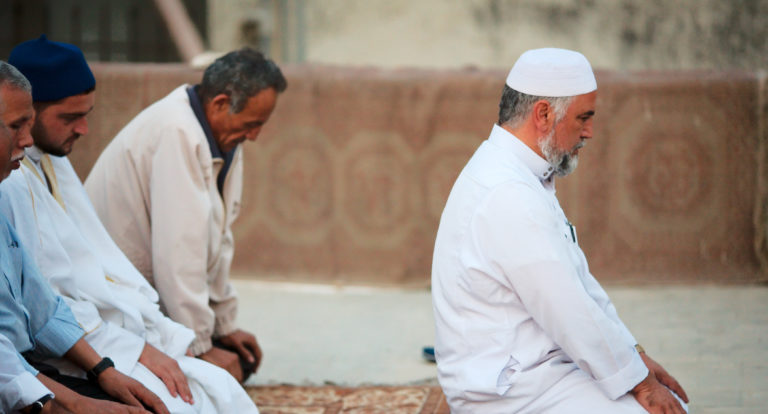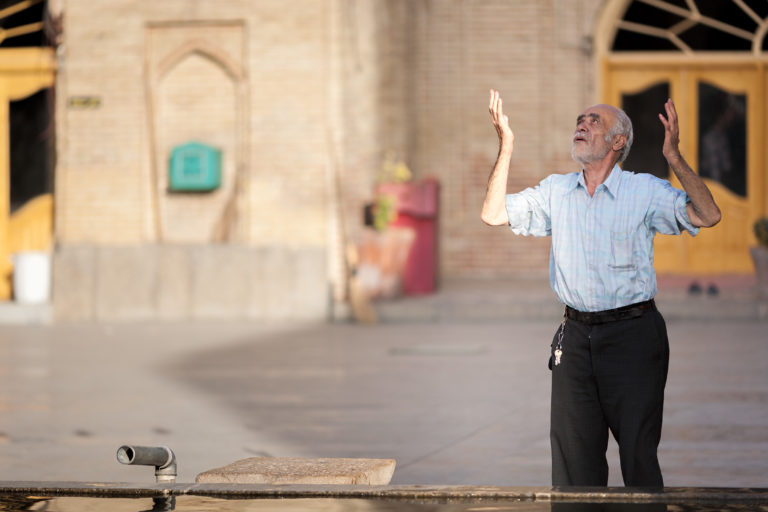There are three moments during prayer where one is required to put him or herself in a sitting (julūs) position during ṣalāh. The first is the sitting between the two prostrations (al-jalsah bayn al-sajdatayn). The second is the sitting for tashahhud. These two instances of julūs are considered required. The third sitting is after the second prostration in every cycle (rakʿah) without tashahhud. The fuqahāʾ are divided on this issue. Many of them believe that one must – either as a definitive fatwā or as an obligatory precaution – rise up from the prostration and come to a sitting position for a moment before standing up for the next rakʿah, such as Sayyid Sīstānī. Other jurists, such as Sayyid Khūʾī and Shaykh Isḥāq Fayyāḍ, believe that although this sitting, called jalsah al-istirāḥah, is a sunnah (pl. sunan) of the Prophet Muhammad (ṣ), it is not obligatory.
In terms of posture while sitting, there is, in fact, no particular position that is required. You may sit however you like, so long as ʿurf (custom) would say that you are sitting, and it will be considered valid. However, there is a particular way that the Sharīʿah has recommended to sit in accordance with the prophetic sunnah. According to the sunnah, you should sit placing your weight on your left thigh with both legs underneath your thighs and to your right; the top of your right foot will rest on the sole of your left foot. In the ʿurf of Shīʿī fuqahāʾ, this is referred to as jilsah al-tawarruk.
There is a famous ḥadīth reported by a prominent companion of Imam Jaʿfar al-Ṣādiq (ʿa) by the name of Ḥammād b. ʿĪsā. During one of their meetings, the Imam asks Ḥammād if he knows how to perform ṣalāh properly. Ḥammād responds that he has memorized the Book of Ṣalāh by another scholar, Ḥarīz b. ʿAbdallāh.[1]Ḥarīz b. ʿAbdallāh al-Sijistānī was a major scholar and transmitter of ḥadīth contemporary to Imam al-Bāqir and al-Ṣādiq (ʿa) and one of Ḥammād’s main teachers. The Imam tells him to demonstrate and so Ḥammād faces the qiblah and begins his worship. After he is finished the Imam laments, “O Ḥammād! you do not perform ṣalāh properly. How disgraceful it is for a man that he may reach the age of sixty or seventy and he cannot perform a single ṣalāh completely with all its guidelines!”[2]The Imam may have chosen this phrasing to make his statement more general and avoid limiting it to Ḥammād. Ḥammād lived to be a little bit over ninety years old and died in about the year 209 AH. Imam al-Ṣādiq (ʿa) was martyred in about the year 148 AH, so Ḥammād would have been somewhere around his early thirties or younger during this incident. Ḥammād was embarrassed and so the Imam stood and demonstrated how to perform ṣalāh properly and Ḥammād describes for us the ṣalāh of the Imam with great detail. Now, when the Imam gets to the first julūs, Ḥammād describes:
“Then he raised he raised his head from prostration and when he was sitting upright he said, “Allāh akbar.” He sat on his left side and placed the top of his right foot on the sole of his left foot.”
In another report, Imam al-Bāqir (ʿa) instructs Zurārah, one of his most intimate students:
“When you sit for tashahhud, place your knees on the ground and leave a little bit of space between them. Let the top of your right foot be on your left foot and your posterior on the ground and the ends of your right toes be on the ground.”
It is reported that a man asked Amīr al-Muʾminīn (ʿa) about the position of raising the right foot and lowering the left foot underneath it. The Imam explained that its esoteric explanation is a supplication, “O Allah, make falsehood perish and establish the truth!”
You may have seen this sitting position before from Sunni Muslims. Most of the Sunni legal schools recommend a variant of tawarruk[3]The difference is that Sunni Muslims do not rest their right foot on the sole of their left foot. Rather, they stand their right foot up with their toes pointing towards the qiblah. in at least some julūses.[4]The Mālikī school recommends tawarruk – sometimes referred to as al-ifḍāʾ – in all julūses. The Shāfiʿī school recommends tawarruk in the final tashahhud of all prayers, while the Hanbalī school recommends tawarruk in the final tashahhud of prayers that are three and four rakaʿāt. According to these last two schools, all other julūses should be in the position of iftirāsh. However, you are also likely to see a different sitting position among them, jilsah al-iftirāsh,[5]The Ḥanafī school recommends all julūses for men be iftirāsh, while for women tawarruk is recommended. where they sit on their left foot rather than on their left thigh.[6]You can see an image of the Sunni variant of tawarruk and of iftirāsh here.
Jilsah al-Tawarruk is recommended in the sunnah for men. There is a unique sitting position for women that is unlike that for men. In a ḥadīth from Imam al-Bāqir (ʿa), he describes how she should sit:
“When she sits, she puts her thighs together and raises her knees from the ground.”
So, this would resemble more of what we might call squatting. Shaykh Ḥasan Najafī in his celebrated forty volume commentary of Sharāʾiʿ al-Islām, Jawāhir al-Kalām, details this sitting posture. He says:
“As for women, tawarruk is not recommended for them, as per what more than one faqīh has noted. In fact, what is well-known from the fatāwā – so much so that consensus is claimed in al-Ghunyah[7]Ghunyah al-Nuzūʿʿilā ʿIlmay al-Uṣūl wa al-Furūʿ is a multidiscipline work covering theology (kalām), legal theory (uṣūl al-fiqh), and statute law (furūʿ al-fiqh) by the jurist Sayyid Ḥamzah b. ʿAlī b. Zuhrah al-Ḥalabī (511 – 585 AH). —is that their julūs is on the posterior while putting their thighs together,raising her knees and legs, and putting both of her feet on the ground.”
Now that we know the mustaḥabb sitting postures for both men and women, you may say that very few people sit like this. Most practicing Shiʿa, male and female, usually sit on top of both their legs and feet, placing one foot over the other. Although sitting like this is valid, it is not mustaḥabb. In the same report where Imam al-Bāqir (ʿa) is teaching Zurārah how to sit for tashahhud, he cautions him:
“Beware of sitting on your feet, as you will be in pain because of that. You will not be sitting on the ground. You will be sitting on yourself, thus not be patient for tashahhud and duʿāʾ.”
Many people are unable to stand for ṣalāh, whether for part of it or all of it, so they perform it seated. Others capable of standing may elect to perform their nāfilah seated. If you do pray seated, then it is recommended, according to Sayyid Sīstānī’s commentary on al-ʿUrwah al-Wuthqā[8]The author of al-ʿUrwah al-Wuthqā, Sayyid Kāẓim Yazdī, says it is recommended to sit with your knees up in front of you, a sitting position called qurfuṣāʾ. However, Sayyid Sīstānī states that what has come in ḥadīth is tarabbuʿ and that it is farfetched that the report intended qurfuṣāʾ. to sit cross-legged, called jilsah al-tarabbuʿ, during the qirāʾah and to fold your legs underneath yourself for rukūʿ. Shaykh Ṣadūq reports a ḥadīth of Imam al-Ṣādiq saying:
“When my father would pray sitting, he would sit cross-legged, and when he did rukūʿ, he would fold his legs underneath [himself].”
The Imams (ʿa) gave importance to these recommended practices, or sunan, so we should strive to incorporate them into our worship as much as is possible. Ḥammād was a major scholar and transmitter of ḥadīth. It is unlikely that when he demonstrated ṣalāh for the Imam, he was conducting it in a way that was invalid. Yet the Imam admonishes him quite strongly. It is also reported that someone came to Imam al-Ṣādiq (ʿa), telling him that he prays in Masjid al-Ḥarām and, due to moisture on the ground, sits on his left foot. The Imam says to him:
“Sit on your posterior, even if you are in mud.”
These recommendations are not meant to put anyone in any sort of ḥaraj (undue difficulty). If one is physically incapable to sit in these postures, it causes them pain, or even if they are in a rush, then it is perfectly fine to sit in some other way. These sunan have not been made obligatory, easing the burden of believers.
To Summarize:
- There are normally three instances of sitting in prayer: Between prostrations, before rising for the next rakʿah, and during tashahhud.
- There is no obligatory way to sit, as long as you are sitting, it is considered valid.
- It is recommended for men to sit in tawarruk and for women to squat with their knees together and raised.
- It is not recommended to sit on your feet.
- It is recommended to sit cross-legged during qirāʾah and to fold your legs under during rukūʿ if you are performing ṣalāh seated.
Notes
| 1. | ⇧ | Ḥarīz b. ʿAbdallāh al-Sijistānī was a major scholar and transmitter of ḥadīth contemporary to Imam al-Bāqir and al-Ṣādiq (ʿa) and one of Ḥammād’s main teachers. |
| 2. | ⇧ | The Imam may have chosen this phrasing to make his statement more general and avoid limiting it to Ḥammād. Ḥammād lived to be a little bit over ninety years old and died in about the year 209 AH. Imam al-Ṣādiq (ʿa) was martyred in about the year 148 AH, so Ḥammād would have been somewhere around his early thirties or younger during this incident. |
| 3. | ⇧ | The difference is that Sunni Muslims do not rest their right foot on the sole of their left foot. Rather, they stand their right foot up with their toes pointing towards the qiblah. |
| 4. | ⇧ | The Mālikī school recommends tawarruk – sometimes referred to as al-ifḍāʾ – in all julūses. The Shāfiʿī school recommends tawarruk in the final tashahhud of all prayers, while the Hanbalī school recommends tawarruk in the final tashahhud of prayers that are three and four rakaʿāt. According to these last two schools, all other julūses should be in the position of iftirāsh. |
| 5. | ⇧ | The Ḥanafī school recommends all julūses for men be iftirāsh, while for women tawarruk is recommended. |
| 6. | ⇧ | You can see an image of the Sunni variant of tawarruk and of iftirāsh here. |
| 7. | ⇧ | Ghunyah al-Nuzūʿʿilā ʿIlmay al-Uṣūl wa al-Furūʿ is a multidiscipline work covering theology (kalām), legal theory (uṣūl al-fiqh), and statute law (furūʿ al-fiqh) by the jurist Sayyid Ḥamzah b. ʿAlī b. Zuhrah al-Ḥalabī (511 – 585 AH). |
| 8. | ⇧ | The author of al-ʿUrwah al-Wuthqā, Sayyid Kāẓim Yazdī, says it is recommended to sit with your knees up in front of you, a sitting position called qurfuṣāʾ. However, Sayyid Sīstānī states that what has come in ḥadīth is tarabbuʿ and that it is farfetched that the report intended qurfuṣāʾ. |










